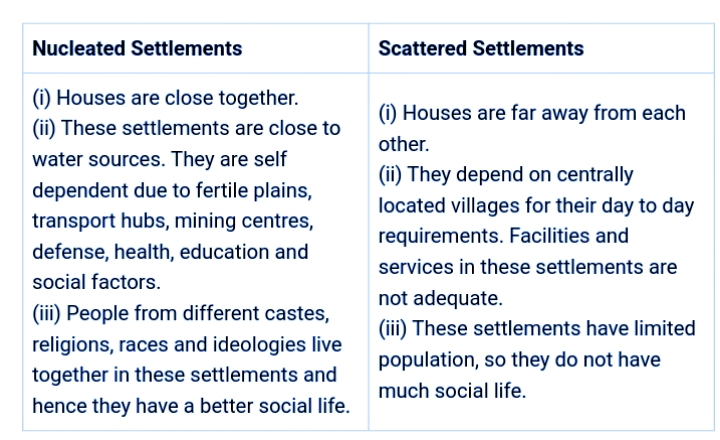Class 7 Geography - 10. Human Settlements/ questions and answers /maharashtra state board
Class 7 Geography - 10. Human Settlements/ questions and answers /maharashtra state board
Q.1. Answer in short.
(1) Explain the various types of human settlements.
Ans: (a) Scattered settlements:
In scattered settlements, houses are few and far from each other.
They are found in the areas of high relief, dense forests, grasslands, hot deserts and extensive agricultural lands.
(b) Nucleated settlements:
These settlements are close to water sources like brooks, rivulets, rivers, lakes, reservoirs, etc.
Fertile plains, transport hubs, mining centres and commercial centres often lead to the development of this type of settlement.
(c) Linear settlements:
Linear settlements are seen along roads, railways, rivers sea coasts and in foothill regions.
They are narrow in shape and spread along a straight line.
2.Differentiate between nucleated and scattered settlements.
3.Explain the natural factors affecting the location of human settlements.
Ans: (a) The natural factors like physiography, land / soils, climate, water supply, river banks, etc. affect the location of human settlements.
(b) Low population & few houses are found in regions of high relief forests, grasslands, hot deserts, etc. whereas high population & nucleated settlements are found in region of fertile plains.
(c) Regions having adequate supply of water has high population & nucleated settlements. Water is essential for occupation of agriculture. Hence early civilizations developed near sources of water like rivers, lakes, reservoirs etc.
(d) In region of extreme climate scattered settlements are found due to difficult living condition whereas in region of favourable climate, nucleated or linear settlements are found.
4.Explain how human settlements have evovled.
Ans: 1.Human settlements have evolved in accordance with the natural conditions.
2.Using the resources from his surroundings, man constructed houses and started living in them.
3.Rural settlement is the first step towards a stable life in human history.
4.Urban settlements have evolved through the expansion and growth of rural settlements.
5.There are large scale correlations between rural and urban settlements
Modernization, science and technology lead to transformation in both types of settlements.
5.Differentiate between a hamlet and a village.
Q. 2. Identify the types of human settlements from the follwing statements. (1) Their money and time is saved by living on the farm.
Ans: Scattered settlements
(2) There is a lot of social life in this settlement.
Ans: Nucleated settlements.
(3) Shops are located on both the sides of the road.
Ans: Linear settlements
(4)This settlement is found at the foothills of mountains or along the coast.
Ans: Linear settlements
(5) Each house is located away from the other.
Ans: Scattered settlement
(6) This settlement is good from a security point of view.
Ans: Nucleated settlements
(7) Having houses away from each other is good for health.
Ans: Scattered settlements
(8) The houses are too close to each other.
Ans: Nucleated settlement
Q.3. Study the diagram and identify the types of settlements.
(A) Settlement ‘A’ has 5-6 houses and the place does not have other facilities.
Ans: Scattered settlement
(B) ‘B’ has a high school, a big market and a small theatre.
Ans:Nucleated settlement
(C) ‘C’ has houses, farms, many shops and small industries.
Ans:Linear settlement
(D) ‘D’ is a natural harbour. Many industries have been established there.
Ans: linear settlement
5. ‘C’ is a settlement that has developed along the roadside. Give two reasons of its location here.
Ans: The reasons for settlement ‘C’ developing along the roadside are:
It has direct & easy access to the main road which helps in easy movement of people & agricultural & industrial goods as houses, farms & small industries are found here.
It is located at the foothill close to the main river.





Comments
Post a Comment